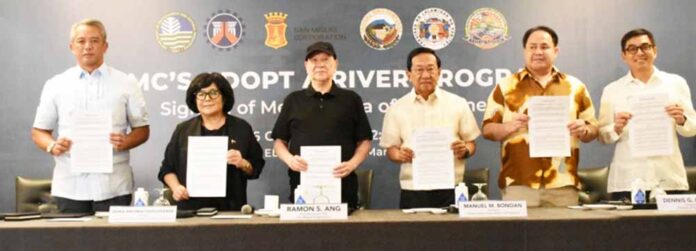CITY OF MALOLOS, Bulacan — Three years after it launched its landmark river cleanup and flood mitigation initiative–which has led to the removal of over 3 million metric tons of silt and solid wastes from the Pasig, Tullahan, and San Juan Rivers — San Miguel Corporation (SMC) is collaborating with various government bodies to clean and rehabilitate three major rivers and waterways in Metro Manila, Pampanga, Cavite, and Bulacan.
SMC’s “Adopt-A-River program” is the country’s biggest corporate social responsibility (CSR) initiative, and is set to be accomplished through partnerships with stakeholders in the local, provincial, and national levels.
The initiative has gained broad-based support from various stakeholders, including national, provincial, and city governments, whose localities stand to benefit from the massive undertaking.
SMC President and CEO Ramon S. Ang signed memoranda of agreement with Department of Environment and Natural Resources (DENR) Secretary Ma. Antonia Yulo-Loyzaga and Department of Public Works and Highways (DPWH) Secretary Manual Bonoan for the initiative.
Also present at the signing and joining the effort were Cavite Gov. Juanito Victor Remulla, Pampanga Gov. Dennis Pineda, and Navotas City Mayor John Ray Tiangco.
“This initiative is unlike anything we have seen before. It is perhaps the most extensive environmental effort involving both government and the private sector. In one decisive move, we are cleaning up many major rivers and waterways. We are doing this as a public service, at no cost to the government or taxpayers,” Ang said.
He added that: “ It is important to understand that cleaning up rivers is not a quick fix. It is a very important step in the river restoration process. It paves the way for polluted waterways to heal.”
SMC began its river advocacy three years ago spending over P3 billion and removing over three million metric tons of oil and waste from the Pasig River, Tullahan River, and San Juan River.
The massive initiative covers the following rivers:
- River systems in Bulacan include the Meycauayan, Maycapiz-Taliptip, and Mailad Rivers, the Bambang Creek, the Marilao River, and Sta. Maria River, Guiguinto River, Pamarawan River, Labangon-Angat River, Malolos River, and Hagonoy River.
- Pampanga River
- Maragondon River and other related tributaries in Cavite
- Waterways in Navotas City, including the Muzon River, Batasan River, and the Navotas River
- San Pedro River in Laguna
- San Juan River
DENR Secretary Yulo-Loyzaga lauded the company for its continuous efforts to clean up major river systems and the expansion of the program, aligned with the government’s environmental objectives.
“This partnership enables DENR to achieve three main mandates by investing and allowing water to flow and impound it correctly where it is needed. Most of all, we were able to fulfill a new role assigned to us by our President when he created the Water Resources Management Office… We are very grateful to San Miguel Corporation for its kind and generous support of our government activities,” Loyzaga said.
For his part, DPWH Secretary Bonoan said: “We commend SMC for taking this noble initiative, for using your own resources and manpower to rehabilitate rivers that will benefit numerous communities and residents of various provinces. The initiative not only reflects the commitment to environment stewardship but also signifies dedication to preserving our rivers that have suffered the brunt of pollution and neglect and human activities.”
The local government partners also extolled the efforts of SMC to clean up waterways in their areas.
“What they plan to do is solve the problem in Noveleta, Rosario, General Trias, and Imus, which comprise maybe 10% of the land area, but 90% of flooding. With JICA and San Miguel, we expect to solve flooding in Cavite 100%,” said Cavite Governor Remulla.
“What affects Bulacan affects Navotas, affects Manila, affects Cavite,” Remulla continued. “(Ramon Ang) brings us together to realize there is hope for this country if we act together.”
For his part, Governor Pineda said: “Noong nakaraang kalamidad, talaga pong namorublema kami kung paano bibigyang solusyon ang baha sa probinsya. Kaya nagpapasalamat po ang mga Kapampangan kay boss Ramon Ang at sa SMC… Alam ko po na ang gagastusin ninyo dito bilyon, pero wala po kayong inaasahan na kapalit. Hindi po namin makakalimutan itong tulong na binigay niyo.”
Navotas City Mayor Tiangco, who lauded SMC’s cleanup of the Tullahan River in support of the rehabilitation of Manila Bay, said: Our ultimate goal is to restore the waters surrounding Navotas to a classification fit for fishing, aquaculture, and other recreational water activities. Hence, we fully support San Miguel Corporation’s Adopt-A-River program and its noble endeavor to clean up and rejuvenate bodies of water.”
Ang said that while the expanded project already covers the major rivers and waterways that significantly contribute to flooding, the initiative may still be expanded as needed, should the government request the coverage of more rivers.
He added that SMC has already started conducting bathymetric studies on the rivers, to determine problem areas that have become shallow due to decades of accumulated silt and garbage. DENR and the company will then develop the appropriate dredging plans.
Over the last three years, as it implemented its ambitious P3-billion cleanup effort for the Pasig River, Tullahan River, and San Juan River, SMC has acquired various specialized heavy equipment that enable it to conduct river cleanup efforts in various conditions more efficiently.
Ang said that its cleanup personnel have also gained significant experience and skill in conducting cleanups efficiently and according to government standards.
SMC’s efforts have been credited with lesser incidences of flooding throughout Metro Manila, despite the yearly succession of typhoons, as the removal of millions of tons of solid wastes has deepened and widened once shallow and heavily polluted rivers.
This has complemented the government’s continuing flood mitigation efforts, including the putting of pumping stations in critical areas. (UnliNews Online)


